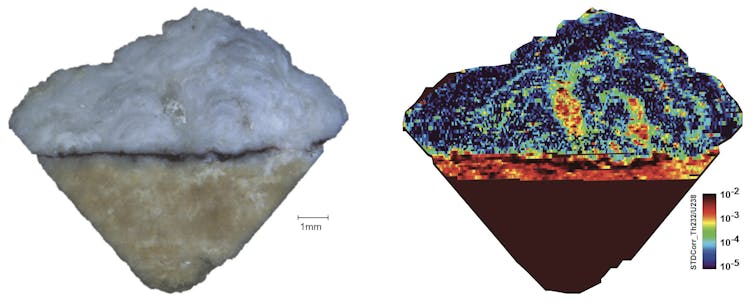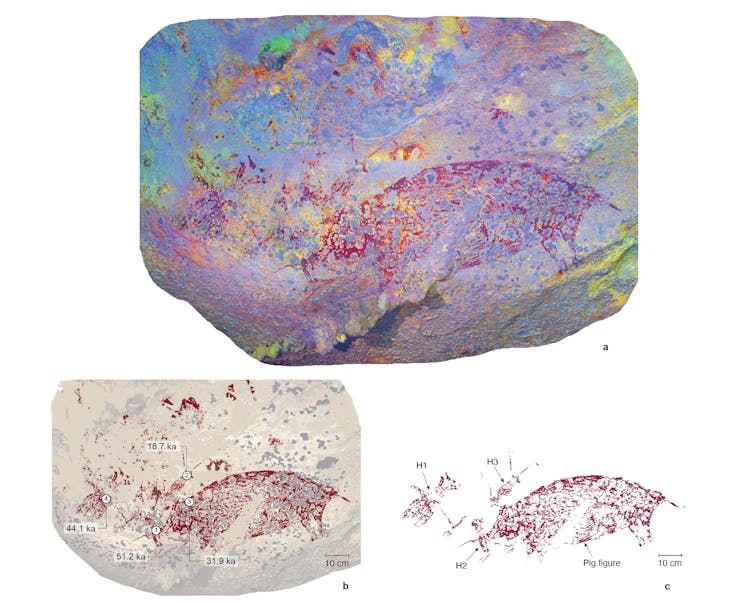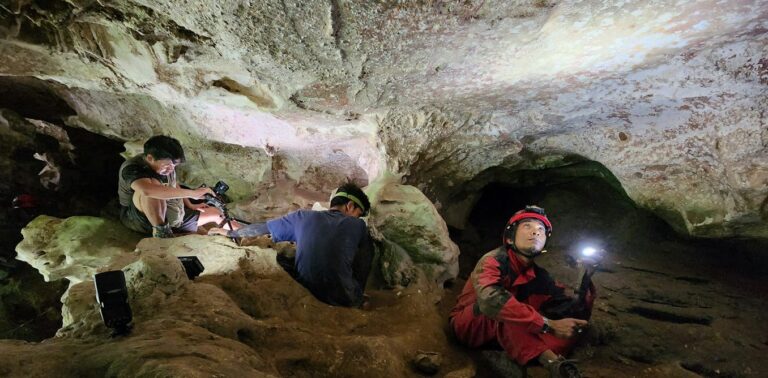Figurative rock art – art that features realistic depictions of subjects – offers a visual glimpse into ancient cultures, beliefs, and societal practices, providing a direct window into human cultural evolution.
Accurately dating figurative rock art is essential. This allows for the establishment of chronologies of human artistic expression, helping to understand the development of symbolic thought and cultural complexity across different periods and regions.
In a paper published today in the journal Nature, we present a new approach to dating cave paintings.
Thanks to this new innovation in dating, we have discovered the oldest figurative rock art in the world.
Dating back at least 51,200 years, this artwork depicts an interaction between a human and a pig. It was discovered in a cave in Sulawesi, an Indonesian island located directly northeast of Bali and east of Borneo.
It is a crucial element of our history as human beings, suggesting that figurative art and storytelling have long been closely linked.
A new pioneering technique
In some limestone caves where people created rock art, dripping or flowing water sometimes caused mineral deposits to form on top of the paint layer, allowing the art to be scientifically dated.
Each drop of water leaves a small amount of carbonate particles, which results in the formation of a whitish layer on the rock art. The same process also leads to the growth of layers of speleothems (also called stalagmites and stalactites), composed of many layers of particles that encapsulate all kinds of elements, including uranium.
Google Arts & Culture
Uranium is a naturally occurring radioisotope, meaning that the chemical element decays into other elements over time.
By comparing the ratio of the parent isotope (uranium) to the daughter isotope (thorium), an age can be calculated proportional to the time it took for the latter to form. This technique is called the uranium series, or U series.
Dating rock art using the U-series is usually done by manually extracting a sample of calcium carbonate and dissolving the resulting powder in a chemical solution, which is then introduced into a mass spectrometer. But the problem with this approach is that it averages several layers of different ages and does not distinguish between intact and altered areas.
To overcome these problems, our team developed a new analytical approach that uses a laser beam, four times smaller than the width of a human hair, to precisely sample the layers of calcium carbonate covering the artwork, including those closest to the painting.

Author provided.
This technique allows us to better understand the internal structure of the calcium carbonate growth that formed on the object. This allows us to identify porous areas within these growths that complicate the dating process.
The laser passes over the samples in parallel lines, called rasters. Once these data are consolidated into a single, high-resolution dataset, we are able to understand the distribution of uranium and associated elements in great detail.
This technique is called “U-series imaging” because it creates a map of the geochemical composition of the sample. We can then extract the data closest to the paint layer, which gives us an accurate estimate of the age.
The dating result is still considered a minimum age estimate, given that there may have been a delay between the creation of the work and the growth of the first layers of calcium carbonate on top.
The art of storytelling
We used this new technique to date a painting in a cave in South Sulawesi called Leang Karampuang and showed that it was at least 51,200 years old.
The painting consists of a scene dominated by a large naturalistic representation of a wild pig. In front of the pig are three smaller, human-like figures. They seem to be interacting with the animal.
One figure appears to be holding an object near the pig’s throat. Another figure stands directly above the pig’s head, upside down, legs spread. The third figure is larger and more majestic than the others; it holds an unidentified object and may be wearing an elaborate headdress.

AA Oktaviana and Ratno Sardi
The way these humanoid figures are depicted in relation to the pig conveys a sense of dynamic action. event in this work – a history is being told.
We do not know what it was about. Perhaps it was the story of a real boar hunt or the representation of a myth or an imaginary tale. In any case, it seems to be about the relationship between pigs and humans as conceived by the first men of Sulawesi.
We now know that figurative art has been used by humans to tell stories for at least 51,000 years. With our new dating method, it may be possible in the future to fill in some of the many gaps in our knowledge of this key development in art history.


